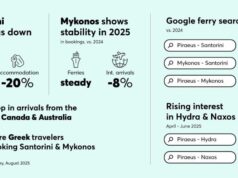 New opportunities for destinations off the beaten track to attract Chinese self-organised travellers
New opportunities for destinations off the beaten track to attract Chinese self-organised travellers
Good news for smaller destinations and attractions all over the world – the second wave of China’s outbound tourism has started. An increasing number of self-organised travellers from China are slowing down and spreading further afield in their quest for prestige and knowledge. This is the message of a workshop organized by COTRI China Outbound Tourism Research Institute which took place in Berlin during the ITB convention on March 8th, 2012.
Prof. Dr. Wolfgang Georg Arlt, director of COTRI, the leading independent research institute in this field: “Increasingly travel-savvy and globally connected, below 45 years and green, the New Chinese Tourists are arriving in more diverse locations and stay for more than just a snapshot.”
China ranks in third position worldwide with regard to both the number of outbound travelers and the amount spent. In 2011 over 70 million mainland citizens travelled abroad, spending close to 70 billion USD. COTRI is forecasting that in 2013 China will overtake Germany and the USA as the No. 1 international tourism source market in the world.
The “New Chinese Tourists” are more often able to speak some English or other foreign languages, many having studied abroad. However, that does not mean that they are not happy to see signage and other information in Chinese, as a sign of respect for their country. During intercontinental trips, self-organised travellers prefer slower travel forms and are more likely to add smaller destinations and special-interest sights and activities to their itinerary. Unlike western backpackers, New Chinese Tourists are wealthier and more willing to spend money on sophisticated branded goods while travelling. It should not be forgotten that more than 1.1 million households in China have over one million USD in cash assets, while the average age of those millionaires is only 39 years.
Chaired by Prof. Dr. Arlt, the workshop at the ITB Berlin, the biggest tourist fair in the world, included presentations by Mr. Thorsten Lind, of Global Blue Germany, who introduced impressive numbers of the shopping performance of Chinese travelers. In many destinations, including Germany, Chinese are the top spenders among all foreign visitors. The Chinese perspective in the workshop was provided by two experts with long-standing experience in Chinese-European tourism business. Mr. Victor Xu Shengli, former head of the German National Tourism Board China office, and London-based Dr. Adam Wu, COO of CBN & MICE, both underlined the need to understand the “second wave” and the special needs and demands of the different segments of the Chinese outbound market. A full-capacity audience of tourism professionals joined the discussion with their own experiences and insights into a market, which nobody in the industry can ignore anymore.
There is still a queue of at least 150 million Chinese people waiting for their turn to join travel groups for shopping in Seoul and photo opportunities in front of the Eiffel tower. “Four nights in Phuket” and “Europe from a coach window” mass-market package tour products, based on low price and corresponding quality, will still represent the majority of tourists in terms of participants, yet not necessary in terms of turnover. However, Chinese international tourism outside of package tours is growing fast. A number of developments have positively influenced the start of the second wave of China’s outbound tourism:
* Rampant consumerism and the growing affluence of the top 5% of Chinese society
* Simplified bureaucratic procedures, making it easier both to obtain passports and hard currency in China and also tourist visas in the destination
* Increased offline and online tourism marketing by national and regional tourism organisations
* Better information about travelling and quality of products (from a Chinese point of view) through social media contacts
* The experiences of repeat-travellers in shaping new interests and increasing the confidence of the New Chinese Tourists
§ Last but not least, increased support from the Chinese government for outbound travel as a form of “soft power” projection.
Say “Ni Hao” to your new customers!
COTRI, based in Heide (Germany) and Beijing (China), is the world’s leading independent research institute for analysis, consulting and quality assessment relating to the Chinese outbound tourism market.











